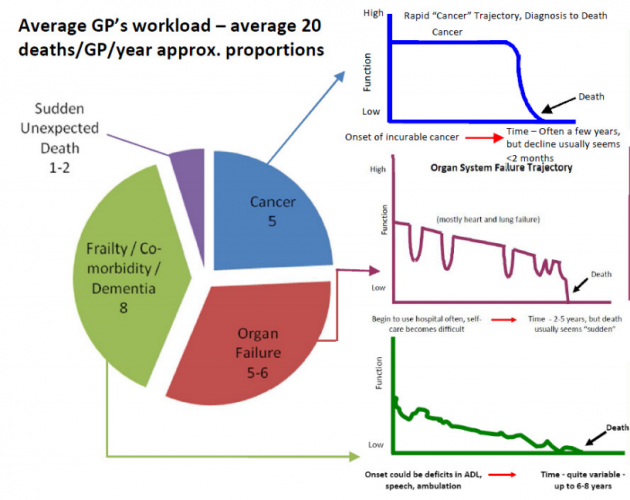Early identification of palliative patients cont...
Disease specific indicators can also be assessed, and these are:
Heart disease
- NYHA III/IV heart failure, severe coronary artery disease, severe valve disease
- Shortness of breath or chest pain at rest or on minimal exertion
- Persistent symptoms despite optimal therapy
- Systolic blood pressure <100mmHg or Pulse >100
- Renal impairment (eGFR <30ml/min)
- Cardiac cachexia
- >1 acute episode needing IV therapy in the last 6 months
Respiratory disease
- Severe airways obstruction (FEV1 <30%) or restrictive deficit (vital capacity <60%)
- Meets criteria for long term oxygen therapy
- Breathless at rest or with minimal exertion between exacerbations
- Persistent severe symptoms despite optimal therapy
- Symptomatic right heart failure
- Low body mass index
- >3 emergency admissions for infective exacerbations or respiratory failure in the past year
Liver disease
Advanced cirrhosis with any of:
- intractable ascites
- hepatic encephalopathy
- hepatorenal syndrome
- bacterial peritonitis
- recurrent variceal bleeding
- Serum albumin <25g/L and raised prothrombin time/prolonged INR
- Hepatocellular carcinoma
- Not fit for liver transplant
Renal disease
- Stage 4 or 5 chronic kidney disease (eGFR<30ml/min)
- Conservative renal management due to multi-morbidity
- Persistent symptoms and/or increasing dependency and deteriorating on renal replacement therapy
- Not starting dialysis following failure of a renal transplant
- Kidney failure or new life-limiting condition as a complication of another condition
Neurological disease
- Complex symptoms with difficulty in controlling
- Progressing speech problems and problems in communicating and/or dysphasia
- Recurrent aspiration pneumonia or respiratory failure
- Progressive deterioration in physical and/or cognitive function despite optimal therapy
Dementia
- Unable to dress, walk or eat without assistance and unable to communicate meaningfully
- Worsening dysphagia needing puréed or soft diet or supplements
- Recurrent infections
- Urinary and faecal incontinence
Cancer
- Metastatic cancer with co-morbidity
- Persistent symptoms despite optimal palliative oncology or too frail for treatment
The rationale for early palliative care is to promote a good quality and holistic approach to the patient and their family. It will usually be patient-led in terms of priorities. It is important to be aware of different disease trajectories (i.e. physical decline in people with advanced illness).
The diagram illustrates these nicely. It should be remembered that people have physical, psychological, social and spiritual needs.

For people riding the ‘rapid cancer trajectory’, acknowledgement of anxiety from an early stage can be highly appreciated.
For people within the ‘organ system trajectory’, early interventions addressing the social and psychological aspects of their illness might be effective.
Those on the frailty trajectory will need social, psychological and spiritual support and building a sense of purpose as people will usually fear a loss of independence.

